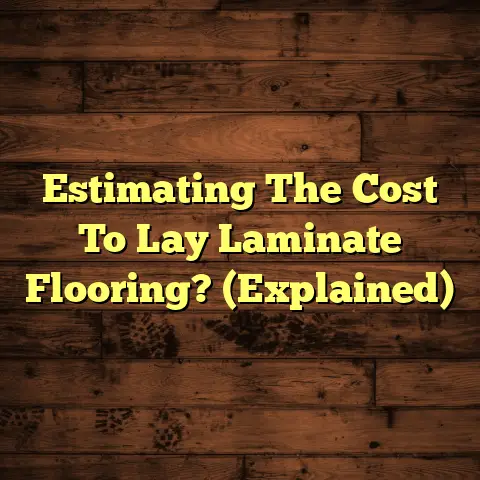Laminate or Vinyl For Basements: Best Choice? (2 Big Risks!)
Let me tell you a story. I had a client, Sarah, a dedicated Golden Retriever mom. Her basement was her dog, Buddy’s, domain – his play area, his napping zone, his kingdom. She was torn between laminate and vinyl flooring, both promising easy cleanup of Buddy’s occasional “accidents.”
But Sarah wasn’t just thinking about convenience. She was worried about Buddy’s comfort, his safety, and the overall air quality of the basement. Choosing the right flooring for a basement, especially when you have furry family members, is a big deal.
Laminate and vinyl are the two frontrunners in basement flooring. They’re popular, relatively affordable, and come in a huge range of styles. But are they really the best choice?
That’s what we’re going to dive into today. I’m going to break down the pros and cons of each, specifically focusing on how they perform in basements and around pets.
More importantly, I’m going to reveal two significant risks associated with each option. Risks that could impact your home, your wallet, and even your health.
So, grab a cup of coffee (or tea!), and let’s get started. By the end of this, you’ll be armed with the knowledge to make the best flooring decision for your basement and your furry friends.
Section 1: Understanding the Unique
Challenges of Basements
Basements are a different beast altogether. They’re not like your living room or bedroom. They have unique environmental challenges that can wreak havoc on flooring if you’re not careful.
Think about it:
-
Humidity: Basements are notorious for being damp. Groundwater seeps through the foundation, and poor ventilation traps moisture.
-
Temperature Fluctuations: Basements can be significantly cooler than the rest of the house, especially in the winter.
-
Potential Water Damage: Leaky pipes, foundation cracks, or even just heavy rain can lead to flooding.
These conditions can significantly impact your flooring choices. Some materials are simply more susceptible to moisture damage, mold growth, and warping than others.
And then you throw pets into the mix! Suddenly, you’re dealing with:
-
Scratching: Claws can do a number on certain flooring types.
-
Accidents: We’re talking pee, poop, and vomit. These can stain, damage, and create unpleasant odors if not cleaned up immediately and if the flooring isn’t properly sealed.
-
General Messiness: Shedding, tracked-in dirt, and spilled food and water are all part of the package.
Durability and easy maintenance become paramount considerations. You need a flooring that can withstand the rigors of basement life and the demands of pet ownership.
Think of it this way: you’re creating a space that needs to be both comfortable for your family (including your pets) and resilient against the unique challenges of a basement environment.
Section 2: Overview of Laminate Flooring
Let’s start with laminate. Laminate flooring is a multi-layered synthetic flooring product fused together using a lamination process. It mimics the look of hardwood, tile, or stone, but at a fraction of the cost.
It’s typically composed of four layers:
-
Wear Layer: A transparent, protective top layer that resists scratches, stains, and fading.
-
Decorative Layer: A high-resolution photographic image that gives the flooring its realistic appearance.
-
Core Board: Usually made of high-density fiberboard (HDF) or medium-density fiberboard (MDF), this layer provides stability and impact resistance.
-
Backing Layer: A moisture-resistant layer that protects the core board from below.
One of the biggest draws of laminate is its aesthetics. You can get the look of expensive hardwood without breaking the bank. It’s also relatively easy to install, especially the click-lock systems.
But how does laminate hold up against pet-related challenges in a basement?
-
Scratch Resistance: Laminate’s wear layer offers good scratch resistance, but it’s not indestructible. Large, active dogs can still leave marks, especially on lower-quality laminates.
-
Ease of Cleaning: Laminate is relatively easy to clean with a damp mop and mild detergent. However, you need to be careful not to use too much water, as it can seep into the seams.
-
Moisture Resistance: This is where laminate struggles. While the backing layer offers some protection, laminate is not waterproof. If water penetrates the seams or if the basement floods, the core board can swell, warp, and delaminate.
And that brings us to the first significant risk:
Risk #1: Moisture Damage
This is the Achilles’ heel of laminate flooring in basements. According to the National Association of Home Builders, basements have a higher risk of moisture problems than other parts of the house. [Source: National Association of Home Builders]
Even small leaks or condensation can cause significant damage over time. Once the core board starts to swell, the laminate is ruined and needs to be replaced.
I’ve seen countless basements where laminate flooring has been completely destroyed by water damage. It’s a costly and frustrating experience. Plus, moisture can lead to mold growth, which poses a serious health risk.
Section 3: Overview of Vinyl Flooring
Now, let’s talk about vinyl. Vinyl flooring is a synthetic flooring made from polyvinyl chloride (PVC). It’s known for its durability, water resistance, and versatility.
There are several types of vinyl flooring:
-
Sheet Vinyl: Comes in large rolls and is installed as a single, seamless sheet. This is the most water-resistant type of vinyl.
-
Vinyl Tile: Individual tiles that are glued down to the subfloor. Offers more design flexibility than sheet vinyl.
-
Luxury Vinyl Plank (LVP) & Luxury Vinyl Tile (LVT): These are thicker and more durable than standard vinyl, and they often mimic the look of hardwood or stone with incredible realism. They come in click-lock systems, making them easier to install.
The benefits of vinyl flooring are numerous:
-
Water Resistance: Vinyl is inherently water-resistant, making it an excellent choice for basements. Sheet vinyl, in particular, provides a virtually waterproof barrier.
-
Durability: Vinyl is tough and can withstand heavy foot traffic, scratches, and impacts.
-
Comfort Underfoot: Vinyl has a slight give, making it more comfortable to walk on than harder surfaces like tile or concrete.
-
Easy Maintenance: Vinyl is easy to clean with a damp mop and mild detergent. It’s also stain-resistant, which is a huge plus for pet owners.
So, how does vinyl perform in basements with pets?
-
Scratch Resistance: Vinyl is generally scratch-resistant, but the level of resistance varies depending on the quality and thickness of the wear layer. LVP and LVT typically offer better scratch resistance than standard vinyl.
-
Ease of Maintenance: Vinyl is a breeze to clean. Pet accidents can be easily wiped up without staining or damaging the flooring.
-
Sound Absorption: Vinyl can help dampen sound, which is especially beneficial in basements where noise can echo.
But here’s the second significant risk:
Risk #2: VOC Emissions
Some vinyl flooring, especially cheaper options, can emit volatile organic compounds (VOCs). VOCs are chemicals that can evaporate into the air and cause health problems, such as respiratory irritation, headaches, and nausea.
According to the Environmental Protection Agency (EPA), VOCs can be particularly harmful in enclosed spaces like basements. [Source: Environmental Protection Agency]
The good news is that many vinyl flooring manufacturers are now producing low-VOC or VOC-free products. Look for certifications like FloorScore or Greenguard to ensure that the flooring meets strict emissions standards.
I always recommend that my clients choose low-VOC vinyl flooring, especially if they have pets or family members with sensitivities. Proper ventilation during and after installation is also crucial.
Section 4: Comparing Laminate and Vinyl
Okay, let’s get down to brass tacks. Here’s a side-by-side comparison of laminate and vinyl flooring, focusing on the key factors that matter most to pet owners with basements:
| Feature | Laminate | Vinyl |
|---|---|---|
| Water Resistance | Limited; susceptible to water damage | Excellent; especially sheet vinyl |
| Scratch Resistance | Good, but can scratch with heavy use | Good to Excellent, depending on type |
| Ease of Cleaning | Easy, but avoid excessive water | Very Easy |
| Comfort | Harder surface | Softer, more comfortable |
| Aesthetics | Realistic wood/tile look | Realistic wood/tile look |
| Cost | Typically less expensive | Varies; can be comparable to laminate |
| VOC Emissions | Low | Can be high; choose low-VOC options |
| Installation | Relatively easy DIY | Easy DIY, especially LVP/LVT |
| Longevity | Moderate, if properly maintained | Long-lasting, especially high-quality |
Installation: Both laminate and vinyl are relatively easy to install, especially the click-lock systems. However, sheet vinyl can be tricky to install yourself, as it requires precise cutting and seaming.
Comfort: Vinyl is generally more comfortable to walk on than laminate, as it has a slight give. Laminate can feel hard and cold, especially in basements.
Aesthetics: Both laminate and vinyl offer a wide range of styles and colors. You can find realistic wood-look planks, stone-look tiles, and everything in between.
Cost: Laminate is typically less expensive than vinyl, but the price difference is narrowing. High-quality LVP can be just as expensive as laminate, if not more so.
Emotional Aspect: Let’s not forget the emotional side of this decision. As pet owners, we want our furry friends to be comfortable and safe. We want them to have a space where they can relax and play without us having to worry about them damaging the flooring or being exposed to harmful chemicals.
I’ve had clients who chose vinyl simply because it gave them peace of mind knowing that their pets were less likely to slip and fall on a wet surface. Others prioritized low-VOC options to protect their pets’ respiratory health.
Ultimately, the best flooring choice depends on your individual priorities and circumstances.
Section 5: Real-Life Case Studies
Let’s bring this all together with a couple of real-life examples.
Case Study #1: The Laminate Lover
Meet John, a proud owner of a Siberian Husky named Luna. John wanted a basement that looked like a stylish extension of his living room. He chose a high-end laminate with a realistic wood-grain finish.
He loved the way it looked and felt that it added value to his home. He also appreciated the lower cost compared to hardwood.
However, a few months after installation, John discovered a small leak in his water heater. The laminate near the leak started to swell and warp.
Despite his best efforts to clean up the water quickly, the damage was done. He had to replace a significant portion of the flooring, costing him time, money, and a lot of frustration.
Key Takeaway: Even high-quality laminate is vulnerable to water damage in basements. Regular inspections for leaks and proper sealing are essential.
Case Study #2: The Vinyl Advocate
Sarah, a cat lover with three rescue kitties, decided to go with luxury vinyl plank (LVP) in her basement. She chose a waterproof LVP with a scratch-resistant wear layer.
Sarah was particularly concerned about her cats’ health, so she made sure to choose a low-VOC product. She also installed a dehumidifier to keep the basement dry.
Years later, Sarah is still thrilled with her decision. The LVP has held up beautifully against cat scratches, spills, and the occasional hairball. It’s easy to clean, comfortable for her cats to walk on, and she has peace of mind knowing that it’s not emitting harmful chemicals.
Key Takeaway: Choosing a waterproof, low-VOC vinyl flooring can be a great option for pet owners with basements. Proper preparation and maintenance are key to long-term satisfaction.
Conclusion
So, what’s the verdict? Laminate or vinyl for basements?
The truth is, there’s no one-size-fits-all answer. Both laminate and vinyl have their pros and cons, and the best choice depends on your individual needs, priorities, and risk tolerance.
Remember the two significant risks:
-
Laminate: Moisture damage.
-
Vinyl: VOC emissions.
Weigh these risks carefully against your personal circumstances. Consider your basement’s moisture level, your budget, your pets’ habits, and your health concerns.
Do your research, read reviews, and talk to flooring professionals. Don’t be afraid to ask questions and get multiple quotes.
Choosing the right flooring for your basement is an investment in your home and your family’s well-being. Take your time, do your homework, and make a decision that you’ll be happy with for years to come.
Call to Action
Now, I want to hear from you! Have you used laminate or vinyl flooring in your basement? What was your experience like? Did you encounter any challenges? Share your thoughts and advice in the comments below! Let’s create a community of shared insights and help each other make the best flooring decisions for our homes and our furry friends.





